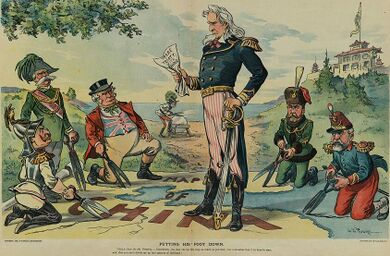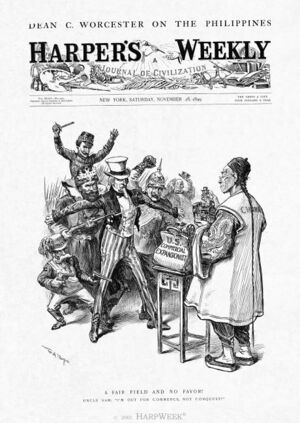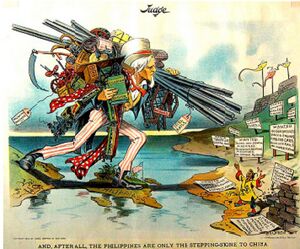سياسة الباب المفتوح

سياسة الباب المفتوح Open Door Policy، هو مفهوم في العلاقات الخارجية، ويشير عادة إلى السياسة في عام 1899 التي كانت تسمح للقوى الاستعمارية المتعددة بالدخول إلى الصين بدون سيطرة أي من تلك القوى على هذا البلد. كنظرية، نشأت سياسة الباب المفتوح مع الممارسة التجارية البريطانية، كم انعكست في المعاهدات التي أبرمت مع الصين في عهد أسرة تشينگ بعد حرب الأفيون الأولى(1839–1842).[1]
كسياسة محددة كانت تتبع مع الصين، مهدت إليها الولايات المتحدة في ملاحظات الباب المتفوح سبتمبر-نوفمبر 1899، التي ألفها ويليام وودڤيل روكهيل.[2] عام 1898، أصبحت الولايات المتحدة قوة شرق آسيوية عن طريق استحواذها على جزر الفلبين، وعنما بدأ تقسيم الصين من قبل القوى الأوروبية وأوشك تقسيم اليابان على الحدوث، رأت الولايات المتحدة أن مصالحها في الصين أصبحت مهددة. أرسل وزير الخارجية الأمريكي جون هاي ملاحات للقوة العظمى (فرنسا، ألمانيا، بريطانيا، إيطاليا، اليابان وروسيا)، يطلب منهم أن يعلنوا رسمياً تمسكهم بأراضي الصينية وسلامة الادارة والأراضي الصينية، وأن ذلك لن يتعارض مع الاستخدام الحرب لمعاهدة الموانئ في حدود مناطق نفوذهم في الصين. أعلنت سياسة الباب المفتوح أن جميع الدول الأوروبية، والولايات المتحدة، يمكنهم التجارة مع الصين.[3]
رداً على ذلك، حاولت كل دولة التهرب من طلب هاي، متخذة موقف عدم الرد حتى تعلن الدول الأخرى امتثالها للطلب. مع ذلك، ففي يوليو 1900، أعلن هاي أن كل واحدة من القوى أبدت موافقة مبدأية على الطلب. بالرغم من أن المعاهدات التي أبرمت بعد عام 1900 كانت تشير إلى سياسة الباب المفتوح، فإن المنافسة بين القوى المختلفة للحصول على امتيازات خاصة داخل الصين لحقوق السكك الحديدية، حقوق التعدين، الرهانات العقارية، موانئ التجارية الخارجية، وغيرها، استمرت بلا هوادة.[4]
تقنياً، قد يشير مصطلح "الباب المفتوح" فقد إلى الفترة التي سبقت تأسيس جمهورية الصين الشعبية عام 1949. أما عن سياسة التجارة الدولية الصينية التي طرحت بعد تولي دنگ شياوپنگ المنصب، فيطلق عليها سياسة الانفتاح الصينية على العالم الخارجي، وكانت معترف في مؤتمر برلين عام 1885، والتي أعلنت أن لا يمكن لأي قوى فرض رسوم تفضيلية في الكونغو.
. . . . . . . . . . . . . . . . . . . . . . . . . . . . . . . . . . . . . . . . . . . . . . . . . . . . . . . . . . . . . . . . . . . . . . . . . . . . . . . . . . . . . . . . . . . . . . . . . . . . . . . . . . . . . . . . . . . . . . . . . . . . . . . . . . . . . . . . . . . . . . . . . . . . . . . . . . . . . . . . . . . . . . . .
خلفية
The theory of the Open Door Policy originated with British commercial practice, as reflected in treaties concluded with the Qing dynasty China after the First Opium War (1839–42) which included most favored nation provisions designed to keep any one nation from gaining an advantage. The concept was seen at the Berlin Conference of 1885, which declared that no power could levy preferential duties in the Congo. As a concept and policy, the Open Door Policy was a principle that was never formally adopted via treaty or international law. It was invoked or alluded to but never enforced as such. The policy collapsed in 1931 when the Japanese seized and kept Manchuria, despite international disapproval. Technically, the term Open Door Policy is applicable only before the founding of the People's Republic of China in 1949. After Deng Xiaoping took power in 1978, the term referred to China's policy of opening up to foreign business that wanted to invest in the country, which set into motion the economic transformation of modern China.[بحاجة لمصدر]

التاريخ
تشكل السياسة
During the First Sino-Japanese War in 1895, China faced an imminent threat of being partitioned and colonized by imperial powers with a presence in China (which included France, Germany, Britain, Italy, Japan, and Russia). After winning the Spanish–American War of 1898, with the newly acquired territory of the Philippine Islands, the United States increased its Asian presence and expected to further its commercial and political interests in China. It felt threatened by other powers' much larger spheres of influence in China and worried that it might lose access to the Chinese market if it were to be partitioned. As a response, William Woodville Rockhill formulated the Open Door Policy to safeguard American business opportunities and other interests in China.[5] On September 6, 1899, U.S. Secretary of State John Hay sent notes to the major powers (France, Germany, Britain, Italy, Japan, and Russia) to ask them to declare formally that they would uphold Chinese territorial and administrative integrity and they would not interfere with the free use of the treaty ports in their spheres of influence in China.[6] The Open Door Policy stated that all nations, including the United States, could enjoy equal access to the Chinese market.[7] Hay's logic was that American economic power would then be able to dominate the Chinese market and fend off other foreign competitors.[8]
In reply, each country tried to evade Hay's request by taking the position that it could not commit itself until the other nations had complied. However, by July 1900, Hay announced that each of the powers had granted its consent in principle. Although treaties after 1900 referred to the Open Door Policy, competition continued abated among the various powers for special concessions within China for railroad rights, mining rights, loans, foreign trade ports, and so forth.[7]
On October 6, 1900, Britain and Germany signed the Yangtze Agreement to oppose the partition of China into spheres of influence. The agreement, signed by Lord Salisbury and Ambassador Paul von Hatzfeldt, was an endorsement of the Open Door Policy. The Germans supported it because a partition of China would limit Germany to a small trading market, instead of all of China.[9][10]
التطورات اللاحقة
The policy built popular sympathy for China and raised hopes for a vast "China market" and American influence in China's development. The effect of the policy was partly diplomatic, but it also reflected what the historian Michael Hunt calls a “paternalistic vision” of "defending and reforming China." This vision defined China in terms of two struggles, first, a Chinese domestic struggle between progressive reform and feudal inertia, and the second an international struggle which pitted the "selfish imperialism" of Britain, Russia, and Japan against the supposedly benevolent policies of the United States.[11] Over the next decades, American diplomats, missionaries, and businessmen took a special interest in China, many of them envisioning that China would follow the American example.[12]
However these dreams proved difficult to realize. American investments, while considerable, did not reach major proportions; the Open Door policy could not protect China against Japanese interference, first the Manchurian Incident of 1931, then the Second Sino-Japanese War (1937–1945), and Chinese leaders, while willing to seek American aid, were not willing to play the passive role that the Open Door implied.[13]
عام 1902، احتجت الحكومة الأمريكية على التعدي الروسي في منشوريا بعد تمرد الملاكمين، وأنه كان انتهاكاً لسياسة الباب المفتوح. عندما حلت اليابان محل روسيا في منشوريا الجنوبية بعد الحرب الروسية اليابانية (1904–1905) وتعهدت الحكومتان اليابانية والأمريكية بالحفاظ على سياسة المساواة في منشوريا. In 1905–1907 Japan made overtures to enlarge its sphere of influence to include Fujian. Japan was trying to obtain French loans and also avoid the Open Door Policy. Paris provided loans on condition that Japan respect the Open Door principles and not violate China's territorial integrity.[14]
في المالية، أدت الجهود الأمريكية للحفاظ على سياسة الباب المفتوح (1909) إلى تأسيس تكتل صرافة دولي which all Chinese railroad loans agreed in 1917 to another exchange of notes between the United States and Japan. There were renewed assurances that the Open Door Policy would be respected, but the United States would recognize Japan's special interests in China (the Lansing–Ishii Agreement). The Open Door Policy had been further weakened by a series of secret treaties in 1917 between Japan and the Allied Triple Entente that promised Japan the German possessions in China after the successful conclusion of World War I.[7] The subsequent realization of the promise in the 1919 Versailles Treaty angered the Chinese public and sparked the protest known as the May Fourth Movement. The Nine-Power Treaty, signed in 1922, expressly reaffirmed the Open Door Policy. In 1949, the United States State Department issued the China White Paper, a selection of official documents on United States-China relations, 1900–1949. The introductory "Letter of Transmittal," signed by Secretary of State Dean Acheson, asserted that the United States policy had consistently maintained fundamental principles, "which include the doctrine of the Open Door...."[15]
Since the policy effectively hindered Chinese sovereignty, the government of the Republic of China endeavored to revise the related treaties with foreign powers in the 1920s and 1930s. However, only after the conclusion of World War II would China manage to regain its full sovereignty.
كان "الباب المفتوح" مبدأ، وليس سياسة معتمدة في معاهدة أو في القانون الدولي. تم الدعوة إليها والحث على اتباعها لكنها لم تدخل أبداً إلى حيز التنفيذ. بدءاً باستيلاء اليابان على منشوريا عام 1931 وتأسيس منتشوكو، غير أن، مبدأ الباب المفتوح انتهك بالافلات من العقاب وبوتيرة متزايدة. [16]
في الصين المعاصرة
In China's modern economic history, the Open Door Policy refers to the new policy announced by Deng Xiaoping in December 1978 to open the door to foreign businesses that wanted to set up in China.[17][18] Special Economic Zones (SEZ) were set up in 1980 in his belief that to modernize China's industry and boost its economy, he needed to welcome foreign direct investment. Chinese economic policy then shifted to encouraging and supporting foreign trade and investment. It was the turning point in China's economic fortune, which started its way on the path to becoming 'The World's Factory'.[19]
Four SEZs were initially set up in 1980: Shenzhen, Zhuhai and Shantou in Guangdong, and Xiamen in Fujian. The SEZs were strategically located near Hong Kong, Macau, and Taiwan but with a favorable tax regime and low wages to attract capital and business from these Chinese communities.[17][20] Shenzhen was the first to be established and showed the most rapid growth, averaging a very high growth rate of 40% per annum between 1981 and 1993, compared to the average GDP growth of 9.8% for the country as a whole.[21] Other SEZs were set up in other parts of China.
In 1978, China was ranked 32nd in the world in export volume, but by 1989, it had doubled its world trade and became the 13th exporter. Between 1978 and 1990, the average annual rate of trade expansion was above 15 percent,[22] and a high rate of growth continued for the next decade. In 1978, its exports in the world market share was negligible and in 1998, it still had less than 2%, but by 2010, it had a world market share of 10.4% according to the World Trade Organization (WTO), with merchandise export sales of more than $1.5 trillion, the highest in the world.[23] In 2013, China overtook the United States and became the world's biggest trading nation in goods, with a total for imports and exports valued at US$4.16 trillion for the year.[24]
On 21 July 2020, Chinese Communist Party general secretary Xi Jinping made a speech to a group of public and private business leaders at the entrepreneur forum in Beijing. Xi emphasized that "We must gradually form a new development pattern with the domestic internal circulation as the main body and the domestic and international dual circulations mutually promoting each other."[25] Since then “internal circulation” became a hot word in China. Some Chinese worry that the emphasis of “internal circulation”signals returning to 1960s-era seclusion, and ending of open door policy.
التطبيقات في القرنين 20 و 21
Scholars such as Christopher Layne in the neorealist school have generalized the use of the term to applications in 'political' open door policies and 'economic' open door policies of nations in general, which interact on a global or international basis.[19]
William Appleman Williams, considered as the foremost member of the "Wisconsin School" of diplomatic history, departed from the mainstream of US historiography in the 1950s by arguing that the US was more responsible for the Cold War than the Soviet Union by expanding as an empire. Pivoting the history of American diplomacy on the Open Door Policy, Williams described the policy as "America's version of the liberal policy of informal empire or free trade imperialism."[26] That was the central thesis in his book, The Tragedy of American Diplomacy.[بحاجة لمصدر]
انظر أيضاً
- اقتصاد الصين
- التاريخ الاقتصادي للصين (قبل-1911)
- التاريخ الاقتصادي للصين المعاصرة
- سياسة الباب المفتوح (الأعمال)
الهوامش
- ^ Philip Joseph, Foreign diplomacy in China, 1894-1901 (1971), ch 1
- ^ Shizhang Hu, Stanley K. Hornbeck and the Open Door Policy, 1919-1937 (1977) ch 1-2
- ^ Sugita (2003)
- ^ Sugita (2003)
- ^ Shizhang Hu, Stanley K. Hornbeck and the Open Door Policy, 1919–1937 (1977) ch 1–2 قالب:ISBN?
- ^ "Secretary of State John Hay and the Open Door in China, 1899–1900". Milestones: 1899–1913. Office of the Historian, U.S. Department of State. Retrieved 17 January 2014.
- ^ أ ب ت Sugita (2003)
- ^ Davis, Stuart (2023). Sanctions as War: Anti-Imperialist Perspectives on American Geo-Economic Policy. Haymarket Books. p. 149. ISBN 978-1-64259-812-4. OCLC 1345216431.
- ^ "Yangtze Agreement", Historical Dictionary of the British Empire (Greenwood Publishing Group, 1996), pp. 1176 قالب:ISBN?
- ^ Paul M. Kennedy, The Rise of the Anglo-German Antagonism: 1860–1914 (1980) pp 243, 354.قالب:ISBN?
- ^ Hunt (1983), p. ix.
- ^ Hayford (1996), pp. 139–141.
- ^ Mark Atwood Lawrence, "Open Door Policy," Encyclopedia of the American Foreign Policy, online.
- ^ Seung-young Kim, "Open Door or Sphere of Influence?: The Diplomacy of the Japanese–French Entente and Fukien Question, 1905–1907." International History Review 41#1 (2019): 105–129; see also Review by Noriko Kawamura in H-DIPLO.
- ^ United States Department of State (1949), p. ix.
- ^ Lawrence, "Open Door" [1]
- ^ أ ب "Open Door Policy". BBC.
- ^ The China-Hong Kong Connection: The Key to China's Open Door Policy. Cambridge University Press. 1992. ISBN 978-0521382458.
{{cite book}}: Cite uses deprecated parameter|authors=(help) - ^ أ ب Xuedong Ding, Chen Meng, ed. (2017). From World Factory to Global Investor: Multi-perspective Analysis on China's Outward Direct Investment. Routledge. ISBN 978-1315455792.
- ^ Swee-Hock Saw, John Wong, ed. (2009). Regional Economic Development in China. Institute of Southeast Asian Studies. pp. 85–86. ISBN 978-981-230-941-9.
- ^ Wei Ge (1999). "Chapter 4: The Performance of Special Economic Zones". Special Economic Zones and the Economic Transition in China. World Scientific Publishing Co Pte Ltd. pp. 67–108. ISBN 978-9810237905.
- ^ Wei, Shang-Jin (February 1993). "The Open Door Policy and China's Rapid Growth: Evidence from City-Level Data". Retrieved 30 October 2018.
- ^ Steven Husted and Shuichiro Nishioka. "China's Fare Share? The Growth of Chinese Exports in World Trade" (PDF).
- ^ Katherine Rushton (10 Jan 2014). "China overtakes US to become world's biggest goods trading nation". The Telegraph.
- ^ Xinhua Net. "(Authorized to publish) Xi Jinping's Speech at the Entrepreneur Forum". Xinhua Net. Archived from the original on 11 August 2020. Retrieved 10 August 2020.
- ^ Williams, William Appleman (1959). The Tragedy of American Diplomacy. New York: W.W. Norton & Co.قالب:ISBN?
. . . . . . . . . . . . . . . . . . . . . . . . . . . . . . . . . . . . . . . . . . . . . . . . . . . . . . . . . . . . . . . . . . . . . . . . . . . . . . . . . . . . . . . . . . . . . . . . . . . . . . . . . . . . . . . . . . . . . . . . . . . . . . . . . . . . . . . . . . . . . . . . . . . . . . . . . . . . . . . . . . . . . . . .
المصادر
- Esthus, Raymond A. "The Changing Concept of the Open Door, 1899-1910," Mississippi Valley Historical Review Vol. 46, No. 3 (Dec., 1959), pp. 435–454 JSTOR
- Hu, Shizhang (1995). Stanley K. Hornbeck and the Open Door Policy, 1919-1937. Greenwood Press. ISBN 0-313-29394-5.
- Mark Atwood Lawrence, “Open Door Policy”, Encyclopedia of the New American Nation, (online)[2].
- McKee, Delber (1977). Chinese Exclusion Versus the Open Door Policy, 1900-1906: Clashes over China Policy in the Roosevelt Era. Wayne State Univ Press. ISBN 0-8143-1565-8.
- Otte, Thomas G. (2007). The China question: great power rivalry and British isolation, 1894-1905. Oxford University Press. ISBN 978-0-19-921109-8.
- Sugita, Yoneyuki, "The Rise of an American Principle in China: A Reinterpretation of the First Open Door Notes toward China" in Richard J. Jensen, Jon Thares Davidann, and Yoneyuki Sugita, eds. Trans-Pacific relations: America, Europe, and Asia in the twentieth century (Greenwood, 2003) pp 3–20
وصلات خارجية
- Text of the First Open Door Note
- Text of the First and Second Open Door Note
- "Milestones: Secretary of State John Hay and the Open Door Policy in China" (U.S. Department of State Office of the Historian) [3]
- Harv and Sfn no-target errors
- CS1 errors: deprecated parameters
- Short description is different from Wikidata
- Articles with unsourced statements from December 2020
- Articles with unsourced statements from August 2021
- العلاقات الأمريكية الصينية
- التاريخ الاقتصادي للصين
- تاريخ التوسعية الأمريكية
- تاريخ العلاقات الخارجية للولايات المتحدة
- العلاقات الخارجية لامبراطورية اليابان

